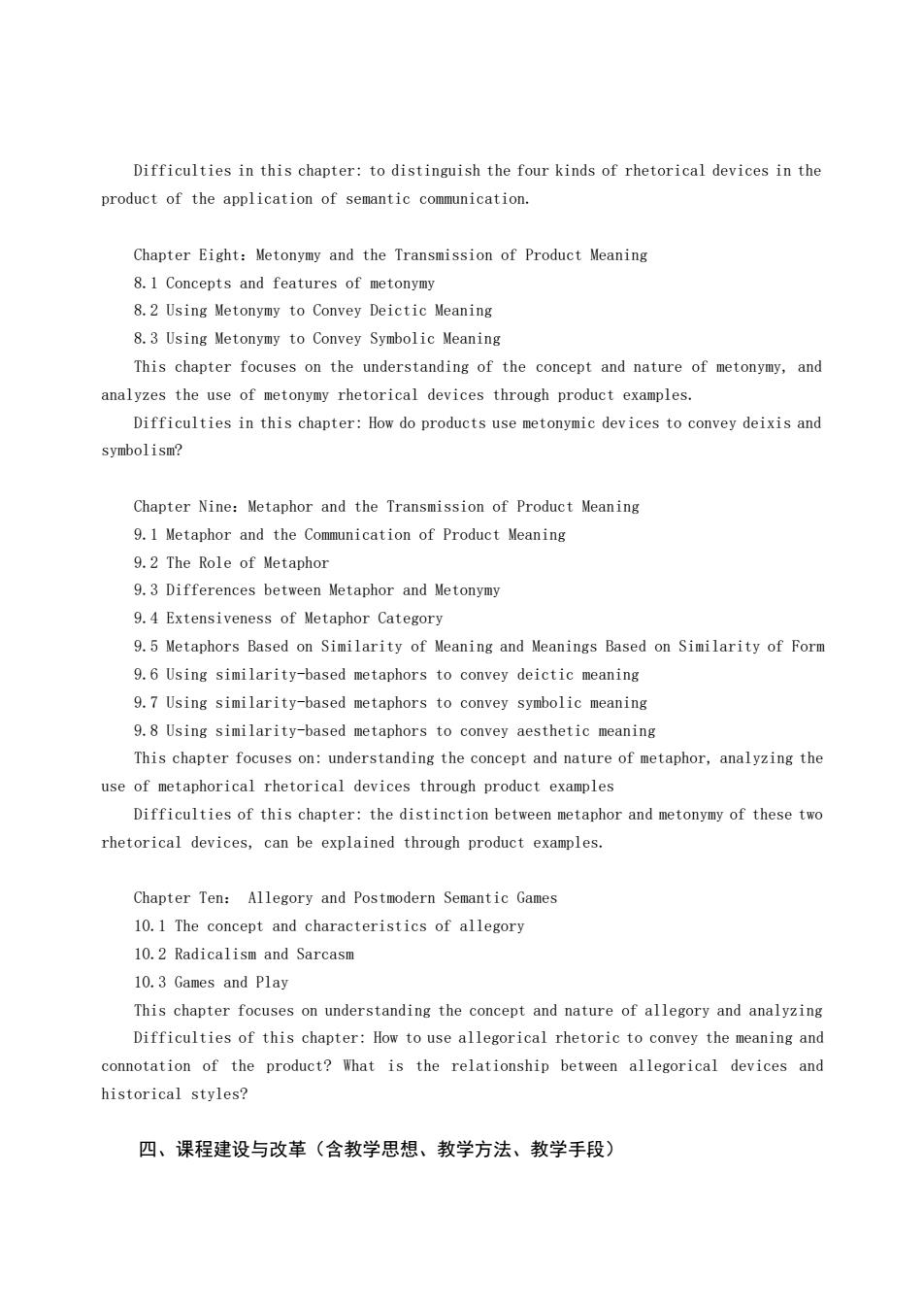正在加载图片...

Difficulties in this chapter:to distinguish the four kinds of rhetorical devices in the product of the application of semantic communication. Chapter Eight:Metonymy and the Transmission of Product Meaning 8.1 Concepts and features of metonymy 8.2 Using Metonymy to Convey Deictic Meaning 8.3 Using Metonymy to Convey Symbolic Meaning This chapter focuses on the understanding of the concept and nature of metonymy,and analyzes the use of metonymy rhetorical devices through product examples. Difficulties in this chapter:How do products use metonymic devices to convey deixis and symbolism? Chapter Nine:Metaphor and the Transmission of Product Meaning 9.1 Metaphor and the Communication of Product Meaning 9.2 The Role of Metaphor 9.3 Differences between Metaphor and Metonymy 9.4 Extensiveness of Metaphor Category 9.5 Metaphors Based on Similarity of Meaning and Meanings Based on Similarity of Form 9.6 Using similarity-based metaphors to convey deictic meaning 9.7 Using similarity-based metaphors to convey symbolic meaning 9.8 Using similarity-based metaphors to convey aesthetic meaning This chapter focuses on:understanding the concept and nature of metaphor,analyzing the use of metaphorical rhetorical devices through product examples Difficulties of this chapter:the distinction between metaphor and metonymy of these two rhetorical devices,can be explained through product examples. Chapter Ten:Allegory and Postmodern Semantic Games 10.1 The concept and characteristics of allegory 10.2 Radicalism and Sarcasm 10.3 Games and Play This chapter focuses on understanding the concept and nature of allegory and analyzing Difficulties of this chapter:How to use allegorical rhetoric to convey the meaning and connotation of the product?What is the relationship between allegorical devices and historical styles? 四、课程建设与改革(含教学思想、教学方法、教学手段)Difficulties in this chapter: to distinguish the four kinds of rhetorical devices in the product of the application of semantic communication. Chapter Eight:Metonymy and the Transmission of Product Meaning 8.1 Concepts and features of metonymy 8.2 Using Metonymy to Convey Deictic Meaning 8.3 Using Metonymy to Convey Symbolic Meaning This chapter focuses on the understanding of the concept and nature of metonymy, and analyzes the use of metonymy rhetorical devices through product examples. Difficulties in this chapter: How do products use metonymic devices to convey deixis and symbolism? Chapter Nine:Metaphor and the Transmission of Product Meaning 9.1 Metaphor and the Communication of Product Meaning 9.2 The Role of Metaphor 9.3 Differences between Metaphor and Metonymy 9.4 Extensiveness of Metaphor Category 9.5 Metaphors Based on Similarity of Meaning and Meanings Based on Similarity of Form 9.6 Using similarity-based metaphors to convey deictic meaning 9.7 Using similarity-based metaphors to convey symbolic meaning 9.8 Using similarity-based metaphors to convey aesthetic meaning This chapter focuses on: understanding the concept and nature of metaphor, analyzing the use of metaphorical rhetorical devices through product examples Difficulties of this chapter: the distinction between metaphor and metonymy of these two rhetorical devices, can be explained through product examples. Chapter Ten: Allegory and Postmodern Semantic Games 10.1 The concept and characteristics of allegory 10.2 Radicalism and Sarcasm 10.3 Games and Play This chapter focuses on understanding the concept and nature of allegory and analyzing Difficulties of this chapter: How to use allegorical rhetoric to convey the meaning and connotation of the product? What is the relationship between allegorical devices and historical styles? 四、课程建设与改革(含教学思想、教学方法、教学手段)